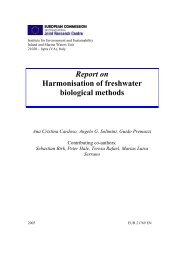Lakes and Watercourses
Lakes and Watercourses
Lakes and Watercourses
Create successful ePaper yourself
Turn your PDF publications into a flip-book with our unique Google optimized e-Paper software.
Acidity / acidification<br />
Introduction<br />
The acidity of water is significant to aquatic organisms because it affects a<br />
number of important biotic <strong>and</strong> abiotic processes. Indirectly, acidity is also<br />
important to aquatic organisms because it governs the chemical form in<br />
which metals occur. Dissolved aluminium is particularly important, since<br />
this may occur in toxic form at high concentrations under acid conditions.<br />
Most waters have a buffering capacity, ie, they are able to neutralise<br />
the input of acidic substances. Buffering capacity is principally determined<br />
by hydrocarbonate; only when this is nearly exhausted can water<br />
become severely acidified. Alkalinity is used here as a measure of<br />
buffering capacity. The lower the alkalinity, the greater the effect of acidic<br />
input on the acidity.<br />
An alternative measure of buffering capacity is ANC (acid neutralising<br />
capacity), which, in addition to hydrocarbonate, also includes organic<br />
anions. The difference between ANC <strong>and</strong> alkalinity is fairly small in clear<br />
waters, but in brown (humic) waters, ANC may be substantially higher<br />
than alkalinity. ANC has become more widely used internationally for<br />
acidification assessments in recent years, although alkalinity has a simpler<br />
<strong>and</strong> clearer correlation to the acidity of water. When alkalinity approaches<br />
zero pH falls most rapidly, regardless of the ANC level at that point.<br />
The water’s natural content of organic anions may have an appreciable<br />
effect on its acidity <strong>and</strong> sensitivity to acidification. However, the fact<br />
that alkalinity rather than ANC has been chosen as the measure of<br />
buffering capacity does not mean that this natural effect is assumed to be<br />
non-existent, nor that it is confused with anthropogenic impact. The<br />
calculation below showing how present buffering capacity differs from<br />
that during the pre-industrial era, solely refers to the change caused by<br />
the sulphur deposition of recent years, regardless of the original acidity of<br />
the water. In practice, this change in buffering capacity will be equally<br />
great, whether it is measured as the difference in alkalinity or the<br />
difference in ANC. However, the estimated correlation between present<br />
<strong>and</strong> pre-industrial alkalinity is easier to use than the equivalent ANC<br />
correlation as the basis for an assessment of whether the pH of the water<br />
has been affected by acid deposition.<br />
36















![Accommodation booking form [PDF]](https://img.yumpu.com/39471785/1/184x260/accommodation-booking-form-pdf.jpg?quality=85)

